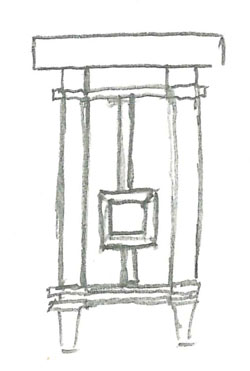
As a kid, probably the first furniture style that I ever became aware of was the Prairie style, the strongly rectilinear forms that most people associate with Frank Lloyd Wright.
My dad had lots of books about architecture lying around the house that he used to help him design the two houses for our farm outside Hackett, Ark. I used these books to help me design model houses that I built using Legos and wooden blocks.
Lucky for me, Prairie-style houses and furniture are easily built with rectilinear Legos. And Wright’s system of proportioning favored 2:1 ratios – that’s the ratio my wooden block set used.
The last piece of the puzzle was the cape that my mom made for me when I was 5 so I could be Superman at Halloween. After seeing photos of Wright wearing a cape, I also took to wearing my cape when I’d build houses and furniture in my room.
I know what you are thinking: It’s amazing that I ever married.
In any case, I’ve always been drawn to Wright’s aesthetic. I’ve visited houses of his in many cities, I’ve been through his furniture and papers at the Prairie Archive at the Milwaukee Art Museum, and one of the highlights of my young life was sitting in one of his original barrel chairs.

So I’m quite excited to get started on a new project for an upcoming issue of Woodworking Magazine – an end table designed in the style of Frank Lloyd Wright. I didn’t want to slavishly copy one of his designs, and so I’m hoping to build a piece that is inspired by a table at the Dana House (one of my favorite tours), and uses geometric forms found at the May House in Grand Rapids, Mich.
I’ve drawn a bunch of sketches, but I decided that this piece really calls out for a full-size prototype in wood. Luckily, we have some thick ash lying around the shop that’s left over from a co-worker’s bench-building project, so there was only a little bit of machine work required to get the parts in shape.
My favorite tool for building prototypes is my Kreg pocket-hole jig. This sucker allows me to assemble and disassemble projects quickly. I screw them together, shake my head at the stupid design choices I’ve made, unscrew the parts, trim them down and then start the process over.
This weekend I got the basic form real close after about three hours of work. My top started out entirely too thick. It was 2″ thick and now it’s more like 1-5/8″. Now I just need to fuss around with the inside guts to get the geometrical designs inside looking good. My No. 1 concern is where I place the large suspended square. Because end tables are typically viewed from a standing position, I need to get it close to the floor.
I’m also a bit worried that things will look too busy inside the table if I put two of these squares in the base. Perhaps I need to go home tonight, put on my old cape (yup, I still got it) and page through some more picture books on Wright.
— Christopher Schwarz